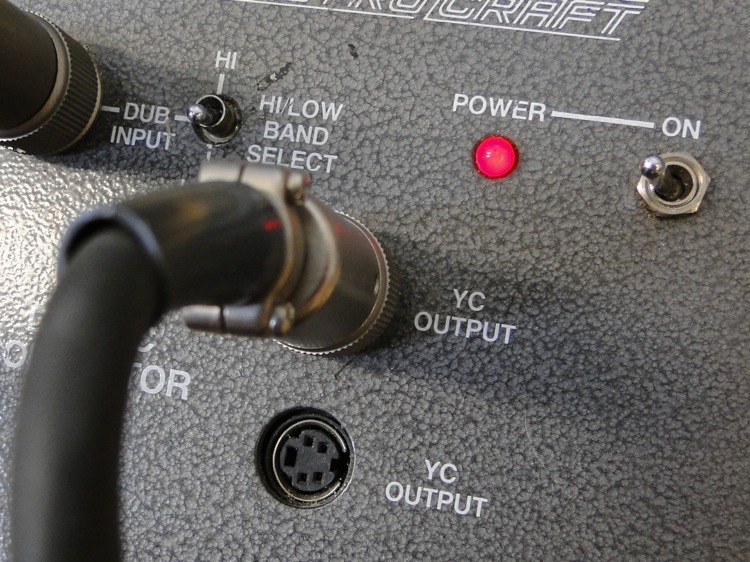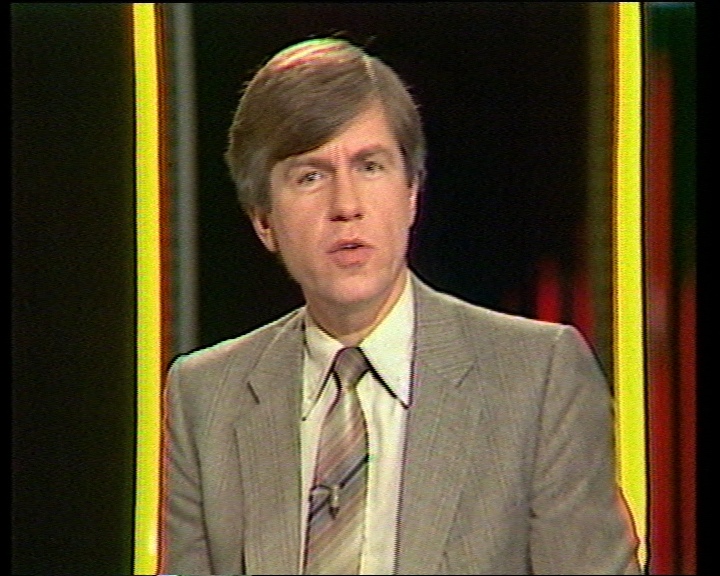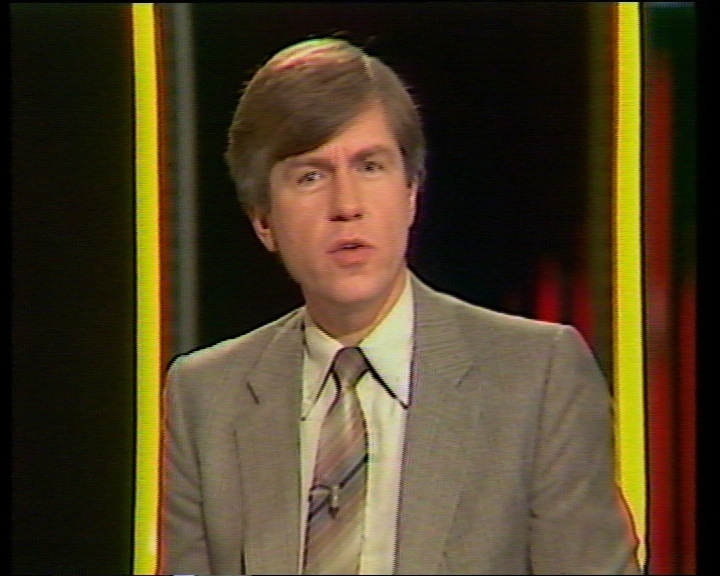
Digitising legacy and obsolete video formats in essence is simple but the technical details make the process more complex. Experience and knowledge are therefore needed to make the most appropriate choices for the medium.
The U-matic video format usually had two types of video output, composite and a y/c type connector that Sony named ‘Dub’. Originally designed as a higher quality method to make analogue ‘dubs’, or for connections in an edit suite, the Dub connector offers a higher performance signal path for the video signal.
It would make sense to use the higher quality dub output when digitising U-matic tapes but here lies the problem. Firstly the connector uses the larger 7 pin y/c type connector that can be quite hard to find connectors for.
Secondly and most significantly, the chrominance subcarrier frequency is not the standard PAL 4.43Mhz but down converted by U-matic recorders to 0.686Mhz for low band recordings and 0.984Mhz for high band recordings.
What this means in practice is that you’ll only get a monochrome image using the U-matic dub connector unless you can find a way to convert the chroma subcarrier frequency back to 4.43Mhz.
There are several solutions:
- Convert this Dub signal chroma frequency using one of a few older Timebase Correctors / Frame Synchronisers from the U-matic era.
These are now rare and often have other other faults that would degrade the signal. - Take the Luma and Chroma signals at the correct frequency directly from certain test points on the circuit boards inside the machines.
This can work well but is a slightly ‘messy’ solution and makes it hard to swap machines around, which is a necessity with older hardware. - Convert the dub signal using a dedicated external dub – y/c converter circuit.
This is our preferred solution that works well technically. It is flexible enough to swap around to different machines easily. It is also a relatively simple circuit that is easy to repair and doesn’t subject the video signal to unnecessary extra processing.
Below are two stills taken from a Apple ProRes recording from a Low Band PAL U-matic tape.
The first image is via the Dub connecter but converted to PAL Y/C.
The second images is via the Composite video out.


It’s clear from the images that there is more fine detail in the picture from the U-matic Dub version. The pattern / texture in the jacket and the texture and tone in the face is more detailed. In contrast, the version digitised through the Composite video connector has less noise but due to the extra encoding and decoding there is less detail and more ‘blurring’.
While less noise may be preferable in some instances, having the option to choose between these two is always better. It’s this kind of attention detail and investment in equipment and knowledge that we are proud of and makes us a preferred supplier of digitising services for U-matic video tape.


[…] of encoding and decoding does not only apply to digital data. Take Betacam video for instance, a component analogue video format introduced by SONY in 1982. If your video was played back using a composite signal cable, the […]
hi, are you saying that inside most umatics the lower frequency Chroma signal off tape is reconverted to the correct frequency before presentation to the Pal encoder. It makes sense I guess (same local oscillator etc for encode/decode), we are trying to find the best source of Chroma , compatible with Y/C for our AJA, rather than making the same box you feature on your web site. We are an engineering company and have to converted LOTS of old family tapes 🙂 We can build a freq converter but before we start we’d like a quick insight. Incidentally, all our tapes were recorded back in 1985 when we had a snell and wilcox engineer working for us, and he made a Y/C link to all our decks, especially between cameras and BVU 150s. So we were doing Y/C before it became S-VHS. thanks, if you can help, thanks if not best of luck, 🙂 Paul PS we played back some old tapes on a deck we rebuilt and the quality is stunning, rather like analogue playback on tube amplifiers has a nicer feel than digital..
Can you refer an engineering company that would work with us in converting our U-MATIC tapes which are both low band and high band format to a digital form? we are based in West Africa .
Thanks
Hi all, TBC unit like the FOR.A FA-301P (which has DUB connections) would be suitable for this purpose? Thank you in advance!
Sorry for the mistake, I meant to say FOR.A FA-310P. Thanks again.
Ok, that’s not possible to transcode DUB signal into SVIDEO through FOR.A FA-310P TBC. Only B/W video is displayed.
By the way, can anyone help me to solve some annoying issues with “Video Phase control” and “Y Delay Sector” settings (I still have 2 vertical bands over the lateral edges that gives chroma fades)? Is there any way to reset the unit to factory settings (i’m afraid not)?
Please help me!
Thank you.
Connect composite from Umatic to TBC and Dub from Umatic to TBC. I belive the tbc uses the composite for chrominance and the luminance from dub since Dub is not compatible with yc. Also if possible you could connect the doc from Umatic to the tbc to fix dropouts. I saw this on video99’s youtube video when doing some research on the topic.
Hello,
Very interesting thread. Concerning solution number 3, can you give me some model of apparels that will do this task?
Thanks
Remy
http://www.digiommel.fi/Optimizing%20Digital%20Transfer%20of%20U-matic%20Video%20Recordings.pdf
Professional solved the problem!!
I suspect the FOR.A FA-310P will do this, but you additionally will need to connect a Composite Video signal as well as Dub. This is certainly the case for the DPS-375 TBC which seems to have similar functionality. Why? Because it uses the Luma signal from Dub, and Chroma is stripped from Composite Video. That’s fine because it’s the Luma signal that is degraded in the Composite Video signal, the Chroma is full resolution (after all if it wasn’t then the whole colour chain in a transmitter would be fairly useless).
Good morning everyone.
I usually use one of my three JVC KM-F250 Frame Synchronizers with a special cable supplied at the time of its distribution to read DUB OUT, both U-Matic Low-Band, Hi-Band or SP, but also DUB OUTPUT VHS from the few professional video recorders equipped with this connection. The cable has both a DUB 7 PIN connection and a CVBS connection for the separate chroma signal.
All these signals are transformed into standard Y/C 4.43 IN and can be internally converted into COMPONENT OUT, with noticeable improvement in image resolution. For the digital conversion I then enter the AJA I/O.
– One of the problems lies in the need to open the JVC and move a jumper not indicated in the instructions, every time you switch from one format to another. For this reason I always keep three JVCs ready: one for DUB VHS, one for U-Matic Low and one for U-Matic HI.
For reading S-VHS video cassettes the problem does not arise because I already have a professional player with built-in TBC and YUV output.
Probably the TBC that you see in this article is more practical, because it has an external switcher for the various DUB formats. Equally I believe there is a FOR.A model (450?) with the same possibilities.
– The two images in this article highlight a problem that it doesn’t mention: the horizontal chromatic shift, i.e. the color phase shift, evident – for example – on the outer edges of the jacket sleeves: that red shade can be corrected directly in phase acquisition, i.e. shifted in perfect register with the other colors in exact correspondence with the luminance signal, ONLY if the video signal is read from the DUB or Y/C output. If the conversion is done by reading the CVBS (composite video) output, correction is not possible.
I hope I have been helpful and of course any suggestions are welcome.
Gabriele Coassin – Plurimedia Edu Lab
Hello
I was reading your replay
we are also in the transfer business
and I have a question in de JVC KMF250 which jumper should I change ? ore need to be removed?
For getting the correct Umatic dub signal?
regards
Michel